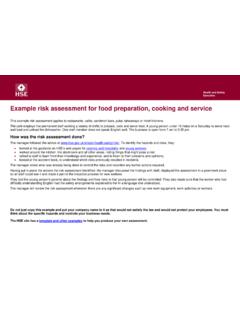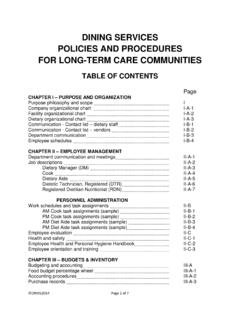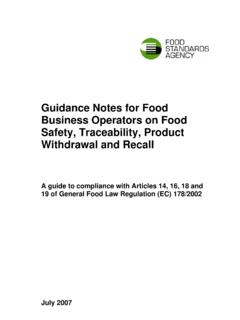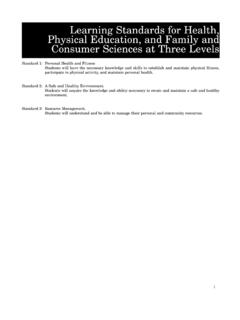Transcription of MODULE 3: FOOD SAFETY, STORAGE & PRESERVATION
1 NUTRITION TRAINING MANUAL: MODULE 3 food safety , STORAGE & PRESERVATION 1 MODULE 3: food safety , STORAGE & PRESERVATION Introduction Ensuring food safety and hygiene is important at individual, household and community level. It ensures that foods are safe for human consumption and that individuals do not develop any food -borne illnesses. This MODULE equips participants with an understanding of key food safety and food hygiene issues and how these can be maintained within households and communities. The MODULE explores different areas with regards to food safety including: food spoilage, food STORAGE and food poisoning.
2 An assessment of the food handling, safety , STORAGE and hygiene practices by workers in Rwenzori and Mpanga tea estates revealed that: Household ownership of food STORAGE facilities varied with only 63% of households reportedly storing food Households that stored food made use of cupboards, containers, baskets, sacks and open floors to store food . Those that did not own food STORAGE facilities mentioned the lack of STORAGE space, consumption of all food prepared and the lack of money to buy food STORAGE facilities as being limiting factors to food STORAGE . Respondents identified the following food hygiene practices.
3 Proper covering of food (68% of respondents), cooking of food (22% of respondents), use of clean utensils in food preparation (5% of respondents), warming of leftover food before consumption (4% of respondents) and keeping cooked and raw foods separately (1% of the respondents) Main challenges in ensuring food safety included the lack of adequate food STORAGE facilities and poor STORAGE methods that result in the destruction of stored food by pests, including cockroaches and rats Objectives of the MODULE By the end of this MODULE , participants should be able to demonstrate good practices with respect to food safety and hygiene, including through food STORAGE and PRESERVATION techniques.
4 They will also learn how to prevent food poisoning. Overview 1. The concept of food safety and hygiene 2. food STORAGE and PRESERVATION 3. food poisoning NUTRITION TRAINING MANUAL: MODULE 3 food safety , STORAGE & PRESERVATION 2 The concept of food safety and hygiene Once food has been harvested, gathered or slaughtered, enzymes and bacteria become active in this food which cause it to deteriorate in texture and composition until it eventually becomes unfit for consumption. This deterioration is known as decay and leads to eventual food spoilage. food safety and hygiene entail undertaking a series of measures to avoid spoilage and contamination of food .
5 At the core of maintaining food safety is the need for proper food handling (incl cooking ), STORAGE and PRESERVATION as these greatly influence how long a food can stay fit for consumption. food is considered safe for human consumption when it is free from substances like contaminants, toxins and micro-organisms that can cause undesirable reactions in the body when such foods are eaten. To ensure that food is safe for consumption, it should be: Protected from contamination by harmful bacteria, poison and other foreign bodies Prevented from having any bacteria present multiplying to an extent which would result in the illness of consumers or the early spoilage of the food For some foods: thoroughly cooked to destroy any harmful bacteria present Discarded when spoilt and/or contaminated The benefits of proper food safety and hygiene are.
6 More efficient utilization of food consumed by the body contributing to improved health and nutrition outcomes Prevention of food -borne illnesses (and sometimes death) Less food wastage Causes of food spoilage Contamination of food stuffs can occur through different ways, including: inappropriate food handling at different stages throughout the food chain; poor hygienic conditions of the places where food is placed, prepared and/or stored; intentional or non-intentional mixing of food with other foods or non- food substances that are unhygienic (also known as food adulteration) and general poor environmental hygiene.
7 food can also be contaminated when put together with other foods that have already undergone spoilage. It is normal for food to spoil when no measures are undertaken to prevent its spoilage. Naturally, foods spoil over time due to the presence of either naturally occurring enzymes in particular foods or due to other external organisms or factors. Fruits and vegetables spoil over time because of the presence of naturally occurring enzymes that cause ripening and eventually, decay. food spoilage may also be caused by micro-organisms such as moulds (commonly seen on bread), or yeasts and bacteria.
8 These cause the food to break down, rot or go sour. The food may then discolour, smell bad or become sticky and slimy. Chemical hazards like pesticides and toxic metals may also lead to food contamination and spoilage. Like other living things, micro-organisms such as bacteria, need food , warmth, moisture and time to grow and multiply. The ideal temperature for most bacteria is 30-45 C. Bacteria thrive best in damp conditions and in moist foods. When the correct conditions for growth are present, bacteria can double in number every 10 to 20 minutes, so that in about six hours 1 million could be produced from just one bacterium!
9 As they increase in number, micro-organisms feed on nutrients present in a food leading to chemical and physical NUTRITION TRAINING MANUAL: MODULE 3 food safety , STORAGE & PRESERVATION 3 changes in the natural composition of the food and eventually food spoilage. Boiling kills most bacteria and cold temperatures slow down their growth. Freezing does not kill bacteria, it only inactivates the enzymes (they stay dormant until they defrost). Identifying spoilt food food that is spoilt can be identified in different ways: Off odours: Foods tend to develop undesirable off-flavours and/or odours as they spoil Discolouration: food undergoing spoilage normally changes in colour Slime / Stickiness: Gravy or soups sometimes become thick and slippery to touch Unusual taste: food that is undergoing spoilage often changes in taste The production of gas: Some foods - especially when stored in sealed containers develop some gases which will be noticeable when opening the container Mould growth.
10 Other foods, bread develop fungi like growth which is easy to see with the naked eye Foods at high risk of food spoilage Some foods are prone to faster spoilage by micro-organisms than others. Foods that spoil fast are usually referred to as high risk foods. Most often these are ready to eat foods or rich protein foods and require refrigerated STORAGE . Examples of these foods are: (Cooked) meat, including poultry (Cooked) meat products including gravy, stews Milk and milk products Eggs and products made from raw eggs (Cooked) Fish food cross-contamination Previously safe food can spoil when it gets contaminated by bacteria from another food in a process known as cross- contamination.







